Restaurant operators, even with fool-proof operations, excellent execution, and delicious meals, face a costly challenge, much of which is driven by inconsistent evaluations across locations.
Imagine all the challenges that you, as a manager, can face, handling multiple locations: The operational chaos, compliance risks, and lost revenue.
Restaurant task management tools bring a standardized solution with digital checklists and forms. But evaluations can drive efficiency in your overall operations only if you strategize them with frameworks that meet your restaurant's needs.
In this blog, we help you build checklists that give you data-driven insights, ensuring that managing evaluations for all the locations is no longer a challenge.
Essential Elements a Restaurant Evaluation Form Must Include
Restaurant quality evaluation frameworks are tailored to assess the overall performance, quality & safety standards, and customer experience for the food industry.
Operations of a restaurant with multiple outlets cause inconsistencies in data collection if not done the right way. Here are some factors listed to consider to make sure the evaluations are actually working for your business:
- Uniform Evaluations: The evaluation processes for operations should be uniform. For this, you can use digital forms and checklists, using common scoring systems like weighted scores, that remain the same for all the venues.
- Defined Goals: Without clear goals, the workers performing the evaluations at different sites will have no clear direction. What is it that you want the evaluations to achieve? A safer workplace, enhance food safety & quality, ensure regulatory compliance, or reduce costs? Based on what your goals are, the evaluation criteria will vary for different operations of your restaurant.
- Metrics for Evaluations: The evaluation forms should offer customizations to track success and revenue for local food units, but it is critical to keep the core metrics (like Table Turnover Rate, Customer Satisfaction Scores, Food Wastage, Average Check Size, Gross Profit Margin) the same for every location you serve.
- Selecting the Right Platform: Pick platforms that collect, analyze, and store all the evaluation data in one place to reduce data loss or inconsistencies.
- Frequency of Evaluations: The frequency of different restaurant evaluations depends on factors like purpose, potential risks, impact, regulatory & compliance standards, etc. Here is a breakdown of evaluation frequency for different operations in the food industry.
Note: This may vary, depending on the operational needs of your company.

Also Read: A comprehensive guide for restaurant assessment!
.svg)

Priced on per user or per location basis
Available on iOS, Android and Web
Best Practices to Build Forms or Checklists for Restaurant Evaluations
- The goals for the restaurant evaluations should be clearly defined. For instance, if your target is to achieve food safety, the evaluations will focus on food preparation procedures, Bluetooth temperature logs for cooking time, storage methods, and sanitizing protocols for kitchen surfaces, utensils, & equipment. For every operation in your food chain, there will be a different focus on what processes, equipment, and data must be evaluated.
- Restaurant evaluations require data input from chefs, waiters, bartenders, and cashiers, so it is important that your evaluation forms are easier for them to understand. For this, use scannable formatting in your forms and checklists with designated sections & sub-sections.
- Visual elements like pictures and videos in your checklists help validate that evaluation tasks were actually performed.
- Consider the functionality of data collections, like specifying if an IoT sensor will automatically monitor data or if human intervention is required.
- Before publishing restaurant performance evaluations, test them in a real environment, ensuring they actually work.
- Ensure the evaluation forms can be accessed from mobiles or tablets.
- The forms should have elements that verify the processes and ensure accountability, using signatures, time stamps, progress trackers, geo-tags, etc.
Reading all this, you must be overwhelmed thinking, “I didn’t know building digital checklists and forms could be this hard!” But thanks to the digitized processes that we have, operation execution platforms like Xenia help you build digital checklists as easily as creating a social media post.
With Xenia, the work becomes simpler and faster with the AI template builder, where, with AI assistance, you can build digital checklists in just seconds. View Xenia’s template library with 1000+ pre-built templates you can integrate into your restaurant evaluation!
You can also create custom evaluation checklists for restaurants, with Xenia’s drag-and-drop method, or convert your existing PDFs into interactive digital checklists using AI.
Evaluation of Restaurants with Advanced Sheet Design Strategies
One thing to note is that evaluations differ across various industries, with unique goals, metrics, and relevant workflows. So, you have to take an extra step of creating evaluation modules that are specific to the restaurant industry.
Wondering how? Here's a quick four-step strategy you can follow:
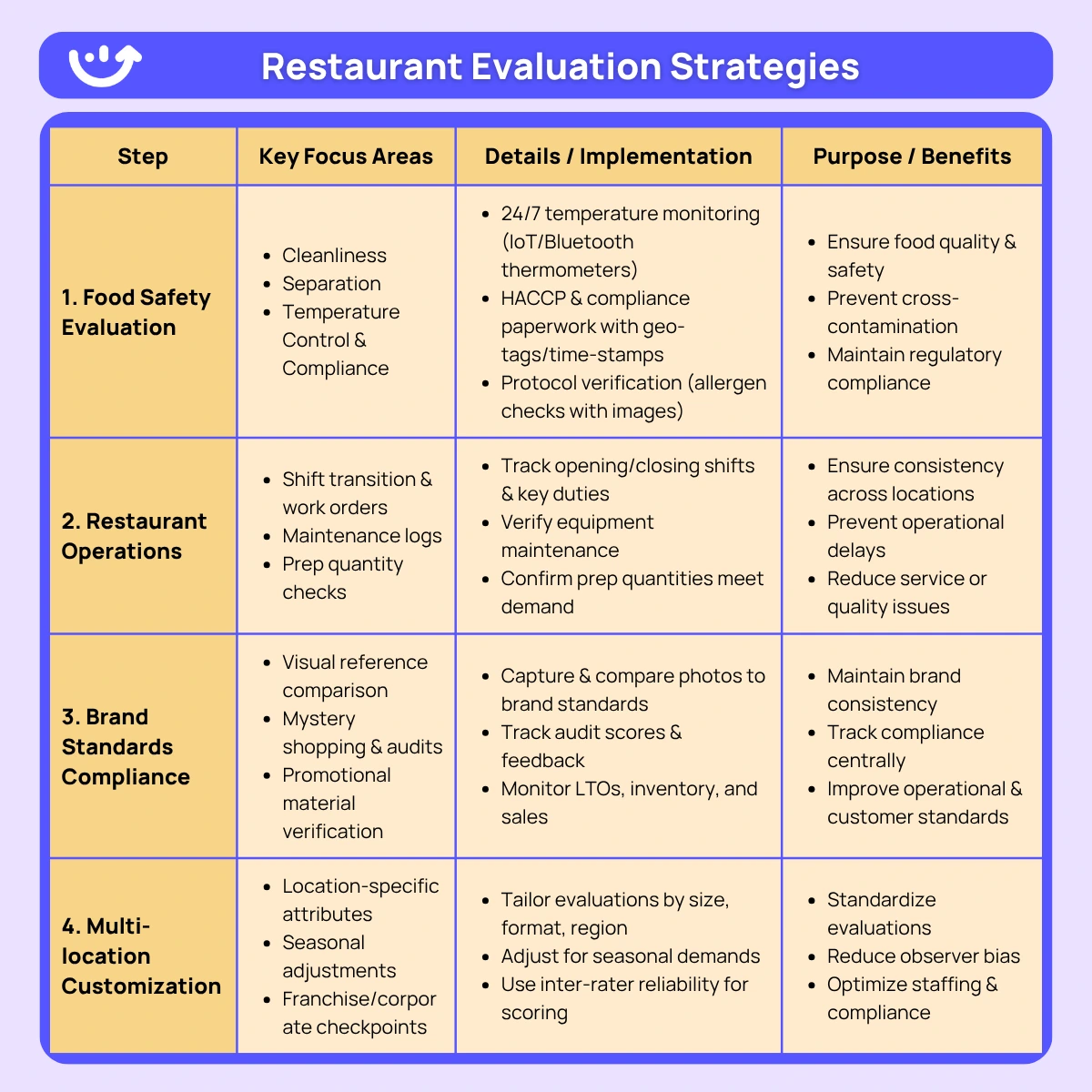
1. Integrate Components of Food Safety Evaluation
Food safety is the most important aspect for a restaurant that often determines the quality and consistency of your service. Your restaurant performance evaluations must be based on four key areas, including:
- Cleanliness (increased safety of staff)
- Separation (prevention of cross-contamination)
- Temperature Control (for cooking and storage)
- Compliance (with health, quality, & safety regulations)
The crucial food safety evaluation components are:
1. 24/7 temperature monitoring for all the cooking procedures, storage units, and freezers, to prevent food spoilage and improve the food quality. Digital temperature logs are used by top food chains to automatically record and maintain data with IoT-based Bluetooth thermometers.
2. Compliance and regulatory paperwork, like HACCP certifications & readiness assessment, with details like time-stamps and geo-tags.
3. Documentation that confirms protocols for different restaurant operations are followed. For instance, if the chef is preparing a meal for customers with certain allergies, managers can add a checklist that verifies the allergen protocol was followed during the meal prep. The chef can further add images of labeled ingredients, utensils, and storage for improved authenticity.
2. Evaluation for Various Restaurant Operations
Restaurant quality evaluations should be consistent and efficient for all locations, and here’s a three-step approach you can follow:
1. Shift Transition & Work Order Documents: Documents for shift transition (including opening and closing shifts) and work orders (like cleanliness, food preparation, guest services, or staff supervision) help verify the consistency of key duties in restaurant operations
2. Maintenance logs: Verifications for equipment maintenance help the evaluators identify any potential malfunction before it escalates into operational failures or safety hazards.
For instance, maintenance records can help evaluators verify which kitchen ovens are functioning properly and which have signs of potential breakdowns simply by referring to the maintenance history.
3. Prep Quantity Checks: Prep quantity checks in the evaluation of restaurants help confirm every unit is equipped and prepared to meet expected demand. You can get insights that help you identify shortfalls and misalignments in prep quantities, delaying services, or reducing food quality.
3. Brand Standards Compliance Evaluation
1. During evaluations, evaluators can capture reference photos and then compare the condition to brand standard images.
2. For mystery shopping evaluations, the results, like audit scores or qualitative feedback, can be attached to the compliance reports (by embedding forms, ratings, or reviews) and tracked individually for every location.
3. Evaluations are not limited to operations and workflows; you can also evaluate compliance and verification of promotional material with visual documentation. Managers can verify if the promotional assets match brand guidelines across all locations from centralized dashboards, from anywhere.
4. You can track the consistency across different locations for LTOs, tracking compliance with brand standards, inventory & stock levels, sales performance, profitability, etc.
4. Multi-location Restaurant Evaluation Customization Strategies
1. Customize the attributes of each location, like size, format (dine-in, quick service, or delivery-only), and region-specific requirements for evaluation of restaurants.
2. Look for modification abilities that support seasonal evaluation adjustments, allowing you to evaluate tasks affected by seasonal impact or holiday periods. Evaluations that support seasonal evaluations can further help to plan scheduling and staffing adjustments for seasonal demands.
3. The evaluations must offer checkpoints for franchise and corporate evaluations, focusing on specific compliance and standardization needs.
4. The restaurant evaluation checklists should help evaluate the requirements of high-traffic or flagship locations, helping to identify task frequency, staffing requirements, and compliance checks.
5. To reduce observer bias, the platform you use must offer inter-rater reliability, enabling consistent scoring among multiple evaluators.
Establish Consistent Evaluations with Xenia
.webp)
Most restaurant operators have adapted and shifted to modern operations execution software. Xenia not only helps with evaluations but also improves overall operations:
1. You can record and analyze real-time data, ensuring no mistakes during data collection and analysis.
2. With automatic calculations, digital evaluations can reduce errors and inconsistencies in scoring.
3. With photo documentation, you actually know evaluations took place. Adding to that, integrated GPS verification further helps authenticate the verification protocols.
Smarter Evaluation of Restaurants with Xenia
Xenia, an all-in-one solution for restaurants, helps food businesses incorporate safety & quality standards and improve efficiency. In the coming section, let’s find out how Xenia’s digital checklists are so competent for every type of food operator.
Conditional Logic
You don't get just the regular evaluations with the restaurant evaluation sheet; Xenia's template builder integrates conditional logic. With this capability, you adapt to real-time inputs like location type, workflow, operational factors, etc.
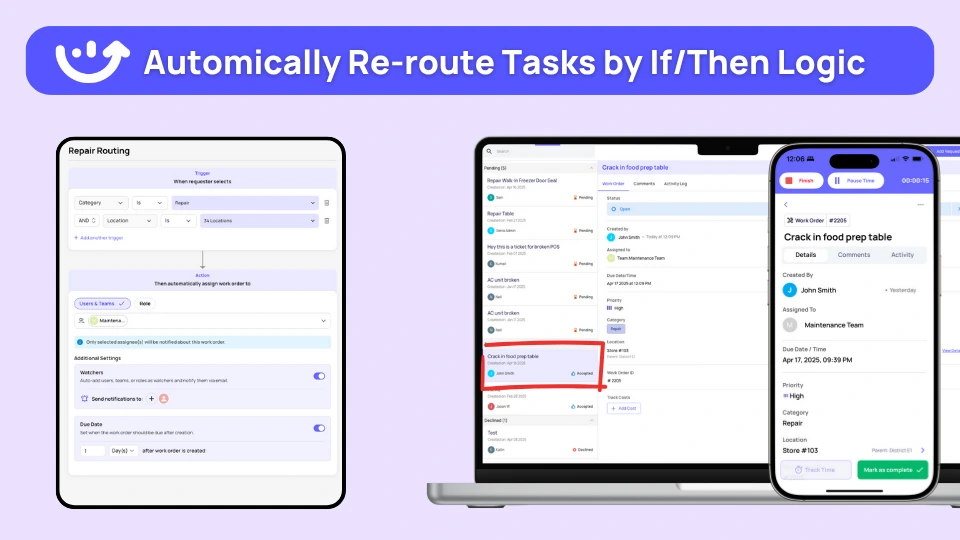
Weighted Scoring
Weighed scoring helps make Xenia's checklists more advanced, using which you are not just getting a "YES/NO" response, but also the relative importance of each question in the overall score.
For instance, you can assign points for specific ranges when evaluating the overall food wastage. Let's say the checklists give a score based on the percentage of food wasted from the total food prepared every week.
0-10% = Score of 1
10-30% = Score of 2
30% and above = Score of 3
Similarly, assigning scores to other aspects like temperature ranges, maintenance for equipment, and hygiene practices, managers can easily identify the criticality of any issue.
Must-read: How to assess & reduce risks to streamline your restaurant's safety.
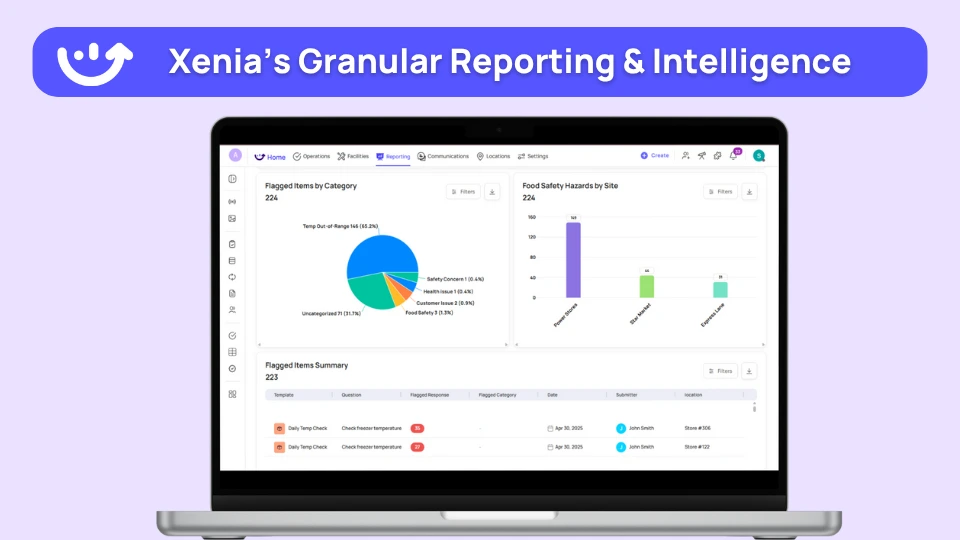
Photo Annotation Capabilities
Photo annotation tools provide the manager with visual proof of evaluations, supporting accountability. In addition, highlighting any issues or risks becomes easier by directly capturing photos within the forms.
To further verify the processes, the digital forms include digital signature fields, steps like confirmation of corrective actions, or verifications of any findings during the evaluation.
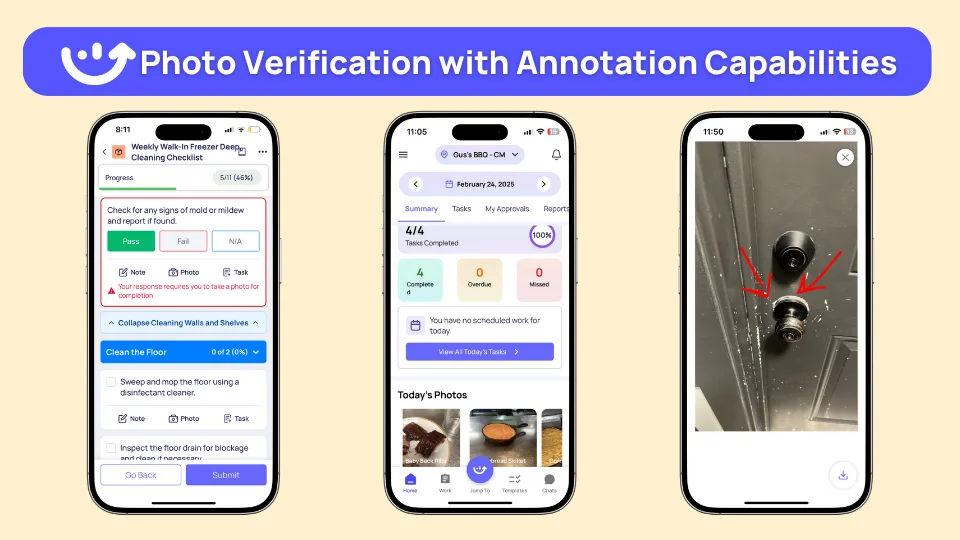
Performance Tracking and Analytics
Xenia provides real-time dashboards, where managers can view and track the completion rates of evaluations, along with performance metrics. By benchmarking multiple units, you can view data, insights, and patterns for all the locations, helping you identify top performers and improvements.
Users can also track improvement by analyzing past incidents or errors, risk exposures, corrective actions, compliance rates, etc., and evaluate effectiveness over time.
AI Capabilities
With AI capabilities, you can create executive summaries and analytics from data collected with different evaluation processes. So, instead of manually compiling all the evaluation data and building reports, you get AI-driven reports in seconds.
You can export these reports in formats like PDF, ensuring a smooth flow of information and data across all locations.

Best Practices for Restaurant Performance Evaluation Success
1. The managers (or evaluators) must understand the scoring criteria for reliable data collection for internal evaluations. To do so, it is recommended that evaluators undergo Evaluator Certification Programs. Having the right knowledge helps improve audit quality, reduce bias, and maintain high inter-rater reliability.
2. Establishing communication channels between evaluation teams and workers helps with quick resolutions in cases of inconsistencies or errors. In addition, transparent communication and a feedback loop between different evaluation teams reduce data inconsistencies.
3. Choose a platform that can manage your restaurant data, provide AI-driven insights & patterns to identify trends, and offer integration capabilities, along with simplifying the evaluation tasks.
4. Every restaurant chain will have numerous audits and inspections, but managers must prioritize high-impact and high-risk tasks that may pose risks and hazards.
5. Track how effective evaluations are by measuring improvements in operational performance.
Move Beyond Paper-Based Evaluations with Xenia: Schedule Your Demo
The evaluation of restaurants with digital checklists and forms can make the audits & inspections faster and better. With drag-and-drop, you can build restaurant evaluation sheets tailored to your business needs.
Not just multi-location restaurant evaluations, but you can get smart solutions for diverse service styles, including QSRs (Quick Service Restaurants), diners, virtual restaurants, etc.
Xenia makes your paper-based evaluations turn digital, without adding much technical complexity. Along with evaluations, you get actionable insights, so you don't just get data but patterns & trends to make data-driven decisions.
It's your chance to revolutionize restaurant evaluation processes with the best form-building platform. Try Xenia's restaurant evaluation tools with our 14-day free trial today!

.svg)
.webp)
%201%20(1).webp)


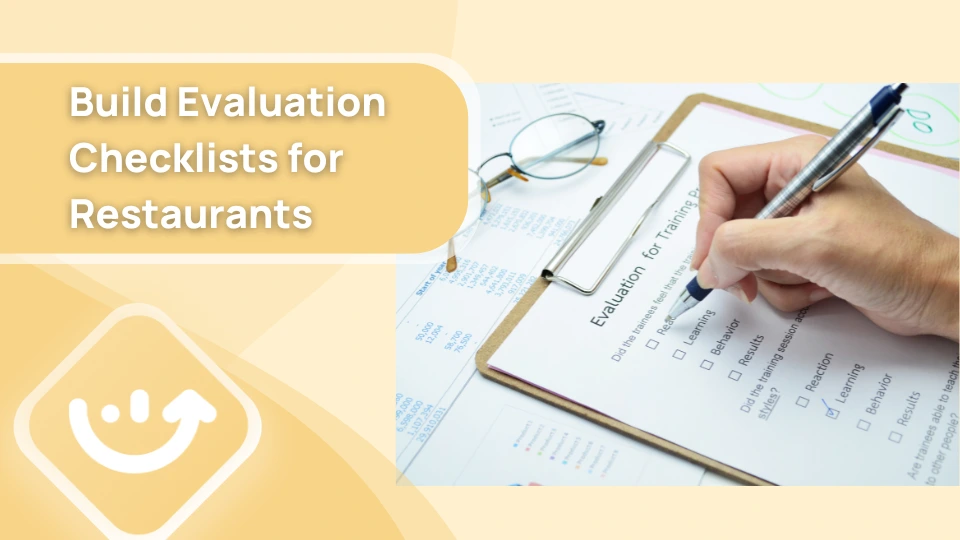


.webp)

.svg)
%201%20(2).webp)








